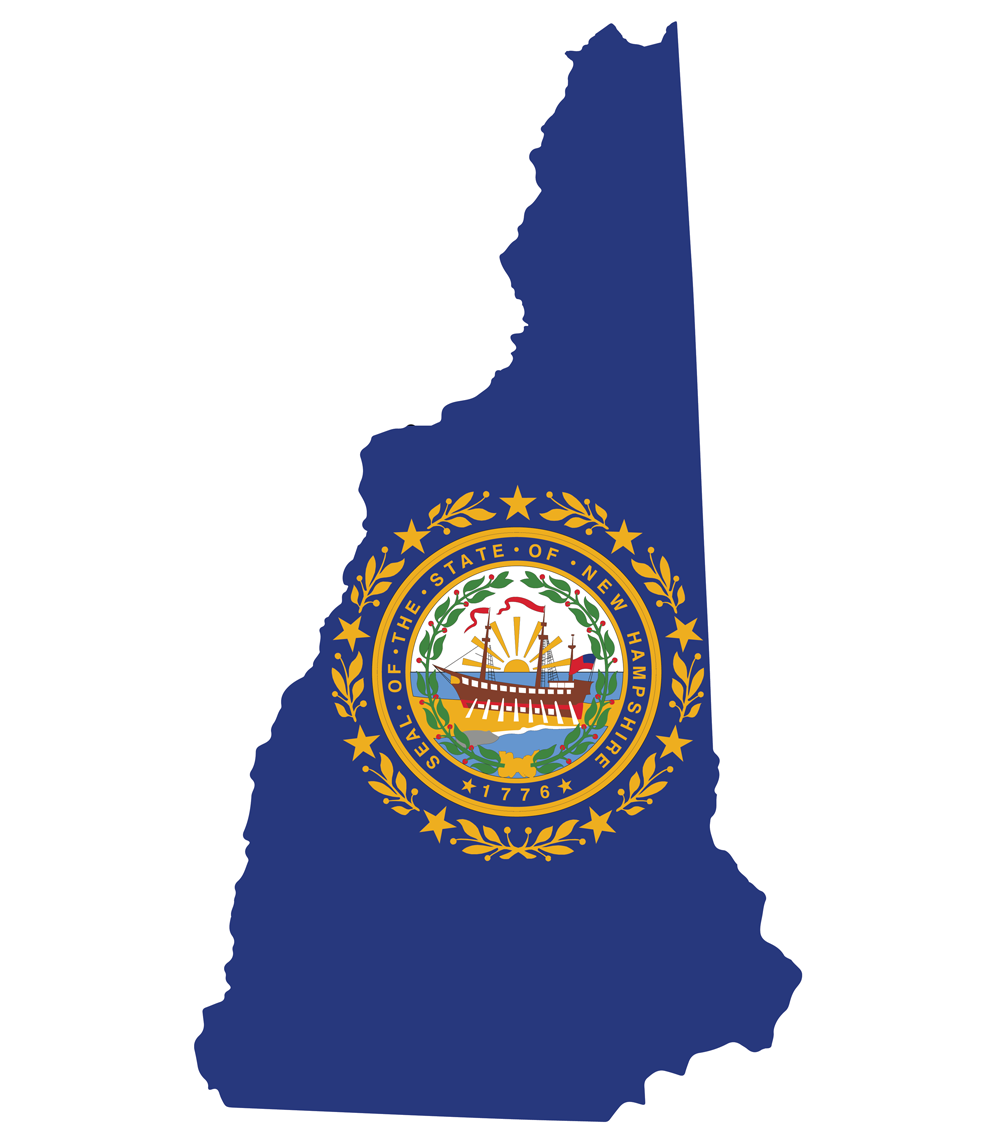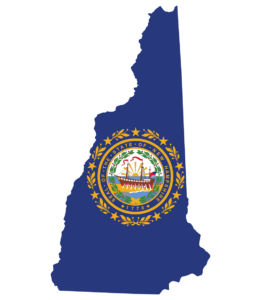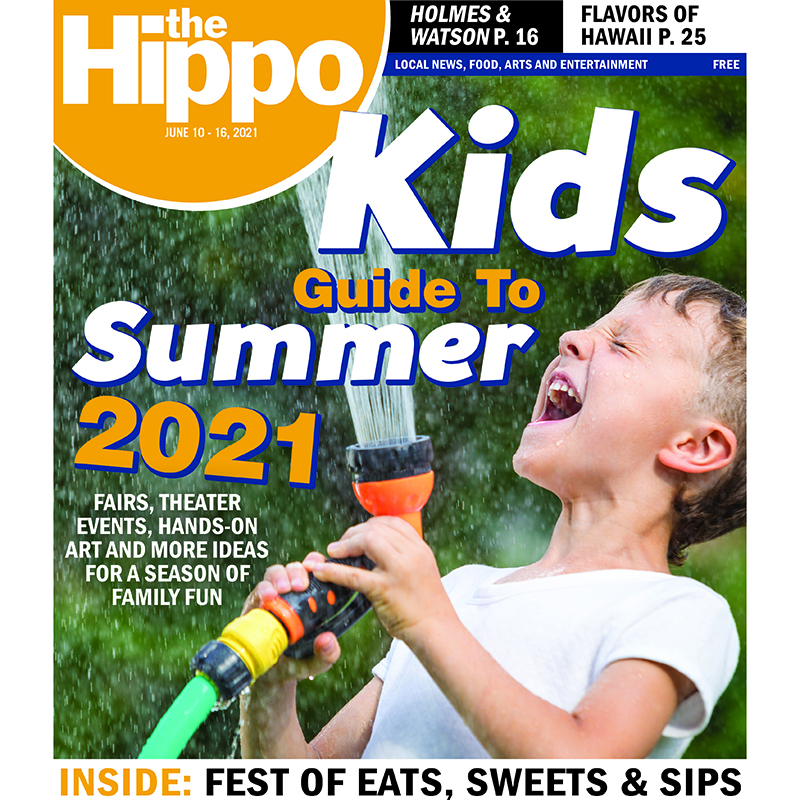Fairs, theater events, hands-on art and more ideas for a season of family fun
As the (very strange) school year comes to a close, you may be wondering what you’re going to do with the kids during the hot weeks ahead. Luckily, there are a whole lot more in-person activities and events planned, from family-friendly musicals and concerts to fairs and festivals. Make plans now to keep the kids happy all summer long.
Fairs & fests
From town fairs and festivals to local sporting events, there are plenty of opportunities to get out and soak up the summer this year. Check out this list of happenings and be sure to call or visit their websites for the most up-to-date information as it becomes available.
• The Wilton Main Street Association will present its annual SummerFest on Saturday, June 19, featuring fireworks and live performances on Carnival Hill in Wilton. Visit visitwilton.com.
• Don’t miss the Hillsborough Summerfest, set for Thursday, July 8, through Sunday, July 11, at Grimes Field (29 Preston St., Hillsborough). The event features carnival rides, local vendors, games, live entertainment, fireworks on Saturday and a town parade and car and truck show on Sunday. Festival hours are 6 to 10 p.m. on Thursday, 5 to 11 p.m. on Friday, noon to 11 p.m. on Saturday and noon to 5:30 p.m. on Sunday. Visit hillsborosummerfest.com.
• The Raymond Town Fair, a multi-day event on the town common featuring contests, parades, live entertainment, children’s activities and more, is scheduled to return from Friday, July 9, through Sunday, July 11. Admission is free. Find them on Facebook @raymondtownfair for updates.
• Sanbornton’s 250th Anniversary Celebration and Old Home Day is scheduled for Saturday, July 10, at 19 Meetinghouse Hill Road. See “Sanbornton Old Home Day” on Facebook.
• The North Haverhill Fair is tentatively scheduled to return from Wednesday, July 28, through Sunday, Aug. 1, at 1299 Dartmouth College Hwy., featuring live entertainment, 4-H animal events and other family-friendly activities. Visit nohaverhillfair.com.
• The Belknap County Fair is due to return on Saturday, Aug. 7, and Sunday, Aug. 8, at 174 Mile Hill Road in Belmont. Visit bcfairnh.org for updates.
• There will be a summertime family fun day at The White Birch Catering & Banquet Hall (222 Central St., Hudson) on Sunday, Aug. 8, from noon to 5 p.m., featuring children’s sack races, a bounce house, games, food and more. Email newenglandvendorevents@gmail.com.
• Hudson’s Old Home Days are due to return to the grounds outside of the Hills House (211 Derry Road, Hudson) from Thursday, Aug. 12, through Sunday, Aug. 15, and will feature local vendors, carnival games, demonstrations, food and more. Visit hudsonoldhomedays.com.
• The town of Epsom has a three-day Old Home Weekend celebration scheduled from Friday, Aug. 13, through Sunday, Aug. 15, at Webster Park in Epsom. Planned events include fireworks, a parade, a bike decorating contest and more. Visit epsomnh.org.
• The Great New England BBQ & Food Truck Festival will return to the Hampshire Dome (34 Emerson Road, Milford) on Saturday, Aug. 14, from 11 a.m. to 7 p.m., featuring food trucks, live music, a cornhole tournament and a “Kidz Zone,” where there will be face-painting, bounce houses and various contests. Tickets are $5 in advance and $10 at the gate (free for kids ages 14 and under). Visit gnecraftartisanshows.com.
• Free Comic Book Day might be a little later than normal this year but the annual celebration of comics is on the schedule — Saturday, Aug. 14. Stay tuned to your favorite comic book shop to find out what they are doing for the big day and get a preview of the special free comic book day issues (including some all-ages offerings) on freecomicbookday.com.
• Londonderry’s Old Home Days return from Wednesday, Aug. 18, through Saturday, Aug. 21, and will feature town parades, games, local vendors and more. Find them on Facebook @townoflondonderryoldhomeday.
• Intown Concord’s annual Market Days Festival, a three-day free street festival, is set to return to Main Street in downtown Concord from Thursday, Aug. 19, through Saturday, Aug. 21. Visit marketdaysfestival.com for the list of ongoing happenings, which have included tastings, live entertainment, food trucks, outdoor movie screenings, a kids zone and other family-friendly activities.
• The Cornish Fair is due to return to 294 Town House Road from Friday, Aug. 20, to Sunday, Aug. 22, featuring agricultural and 4-H exhibits and shows, arts and crafts, midway rides, stage shows, food and commercial exhibits. Admission is $12 for adults, $3 for kids ages 6 to 12 and free for kids under 6. Weekend passes can also be purchased for $30 each. Visit cornishfair.org.
• The annual Battle of the Badges Baseball Classic will return to Northeast Delta Dental Stadium (1 Line Drive, Manchester) on Friday, Aug. 20. Team Police and Team Fire will renew their friendly rivalry in this game to support programs at Children’s Hospital at Dartmouth-Hitchcock (CHaD). Visit chadbaseball.org.
• History Alive returns to the town of Hillsborough on Saturday, Aug. 21, and Sunday, Aug. 22, from 10 a.m. to 3 p.m. Sponsored by the Hillsborough Historical Society, History Alive features live historical re-enactors, live music, presentations about the Abenaki tribe, demonstrations and a children’s parade on Sunday. Visit historyalivenh.org.
• Field of Dreams Community Park (48 Geremonty Drive, Salem) has a family fun day event scheduled for Saturday, Aug. 28, from noon to 6 p.m., when there will be local vendors, children’s games, face-painting, a Touch-a-Truck, live music, food trucks and much more. Admission is free. Visit fieldofdreamsnh.org.
• Plaistow’s Old Home Day will be held on Saturday, Aug. 28, at 51 Old County Road in Plaistow, and is expected to feature local vendors, live entertainment, fireworks, raffles and a road race. Visit plaistowohd.com.
• Gilford’s Old Home Day is currently scheduled for Saturday, Aug. 28, and will likely feature activities like a pancake breakfast, a parade, food and craft booths, games and field events, live music, fireworks and more. Visit gilfordrec.com.
• Candia’s Old Home Day is set for Saturday, Aug. 28, from 11 a.m. to 2 p.m. at Candia Moore Park, next to the town hall (74 High St.), and will likely feature wildlife exhibitors, local vendor booths, a parade and more. Visit candiaoldhomeday.com.
• The Hopkinton State Fair is due to return to 392 Kearsarge Ave. in Contoocook from Thursday, Sept. 2, through Monday, Sept. 6. A Labor Day weekend tradition, the fair will run for five days this year, featuring midway rides, food, educational exhibits, live entertainment and more. Fair hours are from 5 to 11 p.m. on Thursday, 8 a.m. to 11 p.m. on Friday, Saturday and Sunday, and 8 a.m. to 7 p.m. on Monday. Tickets are $29 for teens and adults 13 and up, $22 for seniors over 60, $19 for kids ages 3 to 12 and free for kids under 3. Visit hsfair.org.
• The Manchester Rotary Club will present the 20th annual Cruising Downtown classic car show event on Saturday, Sept. 4, from 10 a.m. to 4 p.m. Around 1,000 unique vehicles will be on display along Elm Street and nearby areas. Visit manchesterrotary.org.
Live entertainment
From theater and music to magic and puppets, there are all kinds of shows for kids and families this summer, both indoors and outdoors.
• The Palace Youth Theatre performs James and the Giant Peach Jr. at the Palace Theatre (80 Hanover St., Manchester) on Friday, June 11, at 7 p.m., and Saturday, June 12, at noon. Tickets cost $12 for children and $15 for adults. Visit palacetheatre.org or call 668-5588.
• Children’s musicians Miss Julieann & Mr. Joey will perform a free concert at Abbie Griffin Park (6 Baboosic Lake Road, Merrimack) on Wednesday, June 23, at 6 p.m. Visit merrimackparksandrec.org/summer-concert-series.
• The Kids Coop Theatre performs Bring It On on Friday, June 25, and Saturday, June 26. More information is TBA. Visit kids-coop-theatre.org.
• Magician BJ Hickman performs a family-friendly magic show at the Palace Theatre (80 Hanover St., Manchester) on Wednesday, June 30, and Thursday, July 1, at 10 a.m. and 6:30 p.m. Tickets cost $10. Visit palacetheatre.org or call 668-5588.
• Cactus Head Puppets will perform a free puppet show in the park at The Belknap Mill (25 Beacon St. E., Laconia) on Monday, July 5, at 10 a.m. Visit belknapmill.org.
• The 2021 Bank of New Hampshire Children’s Summer Series presents a series of shows at the Palace Theatre (80 Hanover St., Manchester) with a Tuesday-through-Thursday run every week in July and August. Shows include Snow White and the Seven Dwarfs July 6 through July 8; Peter Pan July 13 through July 15; Wizard of Oz July 20 through July 22; The Little Mermaid July 27 through July 29; Beauty and the Beast Aug. 3 through Aug. 5; Rapunzel Aug. 10 through Aug. 12; Cinderella Aug. 17 through Aug. 19; and Sleeping Beauty Aug. 24 through Aug. 26. Showtimes are at 10 a.m. and 6:30 p.m. Tickets cost $10. Visit palacetheatre.org or call 668-5588.
• Magician, balloon sculptor and flea circus ringmaster Ed Popielarczyk will perform a free, family-friendly magic show at the Candia Pond Park gazebo (behind the library, 55 High St.) on Wednesday, July 7, at 6:30 p.m. Visit smythpl.org/music-series.
• You’re a Good Man, Charlie Brown will be at the Prescott Park Arts Festival (105 Marcy St., Portsmouth) July 9 through Aug. 15, with shows daily at 7 p.m. Visit prescottpark.org.
• Children’s musician Mr. Aaron will perform a free concert in the park at The Belknap Mill (25 Beacon St. E., Laconia) on Wednesday, July 14, at 10:30 a.m. Visit belknapmill.org.
• Family-friendly indie band Bee Parks and The Hornets will perform at Canterbury Shaker Village(288 Shaker Road, Canterbury) on Sunday, July 18, at 4 p.m. There is a suggested donation of $10 per person. Call 783-9511 or visit shakers.org.
• Everlasting Characters, a group of fairytale character performers, present “Royal Ball,” a free show at the Pelham Village Green (in front of the library, 24 Village Green) on Wednesday, July 21, at 6 p.m. Visit pelhamcommunityspirit.org/sponsored-events/concerts-on-the-village-green.
• Children’s musician Steve Blunt will perform a free concert at Meetinghouse Park at Ordway Park (Main Street, Hampstead) on Wednesday, July 21, at 6 p.m. Visit hampsteadconcerts.com/concert-series.
• The Windham Actors Guild presents a youth production of Seussical outside at Windham High School (64 London Bridge Road, Windham) Thursday, July 22, through Saturday, July 24. More information is TBA. Visit windhamactorsguild.com.
• Strawbery Banke Museum (14 Hancock St., Portsmouth) hosts a kids night of outdoor entertainment featuring music by Mr. Aaron and a bubble magic show by Kali and Wayne of Sages Entertainment on Tuesday, July 27, at 5:30 p.m. The cost is $5 per person. Call 433-1100 or visit strawberybanke.org.
• Folk-rock band Knock on Wood performs a free, family-friendly concert at the Village Common Park Gazebo in Bedford (Bell Hill Road) on Wednesday, July 28, at 6 p.m. Visit bedfordreconline.com.
• Rockin’ Ron the Friendly Pirate will perform a free show of pirate-themed kids music at Abbie Griffin Park (6 Baboosic Lake Road, Merrimack) on Wednesday, Aug. 11, at 6 p.m. Visit merrimackparksandrec.org.
Outdoor fun
Watch a game, head to a farm or stroll through vibrant gardens or wooded trails.
• The New Hampshire Fisher Cats are back to 100 percent capacity at Northeast Delta Dental Stadium (1 Line Drive, Manchester), and will next take on the Hartford Yard Goats during a home stand that begins Tuesday, June 15, at 6:35 p.m. Upcoming theme days include Comic-Con night on Friday, June 18, “Kids Run the Bases” on Sunday, June 20, and Sunday, July 25, and fairly regular fireworks.
• The Nashua Silver Knights recently kicked off their 2021 season and will next play at Holman Stadium (67 Amherst St., Nashua) on Saturday, June 12, at 6:30 p.m., against the Norwich Sea Unicorns. Upcoming theme days include Health Care Heroes Night & Fireworks Friday on Friday, June 18, and Father’s Day Necktie Giveaway and Kids Club Sunday on Sunday, June 20. Visit nashuasilverknights.com.
• The New Hampshire Farm Museum (1305 White Mountain Hwy., Milton) will host Children’s Day on Saturday, June 19, from 10 a.m. to 4 p.m. Kids can get their pictures taken with the farm’s animals and try their hand at horseshoes, bean bags, hoops of grace and more. The museums annual Fourth on the Farm Fourth of July celebration will be held on Sunday, July 4, from noon to 3 p.m. Guides in period dress will be serving strawberry shortcake with homemade whipped cream on the porch, while local musicians will be performing and tractor rides will be available throughout the farm. Museum admission costs $10 for adults, $7.50 for seniors over age 64, $5 for kids ages 4 and up and free for kids under age 4 and for members and active military. The Farm Museum summer hours (running through August) are 10 a.m. to 4 p.m. Wednesday through Sunday. Visit nhfarmmuseum.org.
• Squam Lakes Natural Science Center (534 Route 3, Holderness) celebrates its new raptor exhibit with “All About Birds Day,” held the first Thursday of each month from July through September. There will be a pop-up Animal Encounters exhibit featuring live raptors, with naturalists standing by to answer questions. Animal Encounters will also host a pop-up exhibit on “Fur, Feathers, and Scales Day” on Thursday, July 15, featuring mammals, birds and reptiles; and at “Have to Have a Habitat Day” on Tuesday, Aug. 10, with animals that live in various kinds of habitats. The live animal exhibit and hiking trails are open daily from 9:30 a.m. to 5 p.m., according to the website, where you can pre-purchase passes. Admission is $18 for adults and seniors, $13 for ages 3 to 15 and free to children ages 2 and under. Visit nhnature.org.
• Do a little hiking and see some animals at the Educational Farm at Joppa Hill (174 Joppa Hill in Bedford; theeducationalfarm.org, 472-4724) which is open daily from dawn to dusk. Admission is free. A trail map is available online, as is an animal scavenger hunt. A farm stand is also open Wednesday, 3 to 6 p.m. and Saturday and Sunday, 10 a.m. to 4 p.m., the website said.
• Charmingfare Farm (774 High St. in Candia, visitthefarm.com, 483-5623) features farm animals (alpacas, cows, peacocks, goats and more), some of whom you can meet in the petting zoo, and animals in the wildlife exhibits (racoon, fox, bobcat, owl), according to the website, where you can purchase tickets for $22 per person (kids 23 months and younger get in free). The farm is open to visits Friday through Sunday, 10 a.m. to 4 p.m.
• Travel back to a simpler time at Canterbury Shaker Village (288 Shaker Road, Canterbury), a restored Shaker village and history museum with historic buildings, interactive exhibits and activities, educational programs and more. The Village grounds and trails are open every day from dawn to dusk with no admission fee. Guided tours will be offered Tuesday through Sunday starting on June 12, with outdoor general tours at 11 a.m., indoor general tours at 1 p.m., and indoor themed tours at 3 p.m. Tickets cost $20 for general tours and $25 for themed tours and are free for visitors age 25 and under. Purchasing tickets in advance is encouraged, but walk-ins will be permitted based on availability. Call 783-9511 or visit shakers.org.
• Learn about marine life and science at the Seacoast Science Center (Odiorne Point State Park, 570 Ocean Blvd., Rye). The museum features indoor and outdoor tide pools and touch tanks with live animals and a variety of hands-on exhibits. Exhibits currently on display examine whales and seals; coral reefs; undersea exploration and engineering; the marine habitat on the Gulf of Maine; keeping New Hampshire beaches clean and more. Current hours are Friday, Saturday and Sunday, from 10 a.m. to 4 p.m. Starting June 23, hours will expand to Wednesday through Sunday, from 10 a.m. to 4 p.m. Entry is permitted on the hour. Getting tickets in advance is encouraged, but walk-ins are welcome if space allows. Tickets cost $10 for adults and kids age 12 and up; $8 for seniors age 65 and up; $8 for active duty military and veterans; $5 for kids ages 3 through 11; and are free for kids under age 3. Call 436-8043 or visit seacoastsciencecenter.org.
• Spend the day out in nature at Beaver Brook Association (117 Ridge Road, Hollis) which has more than 35 miles of maintained trails, open every day from dawn to dusk. The trails cut through diverse landscapes, including forests, fields and wetlands and are home to a variety of wildlife. Admission is free. A number of different trail maps and accompanying guidebooks with pictures for identifying wildlife are available on the website. Call 465-7787 or visit beaverbrook.org.
• The New Hampshire Audubon’s McLane Center (84 Silk Farm Road, Concord) is now open to visitors, featuring live animals and exhibits, including the Reptile Room and raptor mews, and a Nature Store. Admission is free. Hours are Tuesday through Friday from 11 a.m. to 4 p.m. The trails and gardens at both the McLane Center and the Massabesic Audubon Center (26 Audubon Way, Auburn) are open daily from dawn to dusk with no admission fee. Call 224-9909 or visit nhaudubon.org.
Arts & museums
You can work a pottery wheel, see animals up close, reenact history and more at these special events and programs hosted by local museums and educational centers.
• The Children’s Museum of New Hampshire (6 Washington St. in Dover; childrens-museum.org, 742-2002) is open Wednesday and Sunday mornings and Thursday, Friday and Saturday mornings and afternoons. Go online to reserve a play session. Newly open this year is the Play Patio billed as a place for “messy creative fun,” according to the website.
• Currier Museum of Art (150 Ash St., Manchester) offers Creative Studio, a themed art-making project for families, every second Saturday from 11 a.m. to 4 p.m.. which is free for New Hampshire residents. On the third Saturday of every month, it hosts Art for Vets Family Days, where veterans and active military members and their families get free admission to the museum and can enjoy art-making activities and a complimentary lunch. Registration is required for all special events. Reserved timed tickets for the Currier are available online. The museum is open Thursdays from 10 a.m. to 8 p.m. and Friday through Sunday from 10 a.m. to 5 p.m. Admission costs $15 per person ($13 for seniors, $10 for students, $5 for youth ages 13 to 17 and free to children 12 and under). Call 669-6144 or visit currier.org.
• Studio 550 Art Center (550 Elm St., Manchester) offers an all-ages family clay sculpting workshop for $25 per person and a family pottery wheel workshop for kids ages 9 and up for $30 per person every Saturday at 4, 5:15 or 5:30 p.m., depending on the day. Call 232-5597 or visit 550arts.com.
• Join the Aviation Museum of New Hampshire for its annual “Welcome Summer” Fly-In Barbecue on Saturday, June 19, from 10 a.m. to 2 p.m., at the hangar of Jet Aviation at Nashua Airport (83 Perimeter Road). Families will have the chance to check out all kinds of vintage aircraft and cars, as well as the Aviation Museum’s “Rob Holland Experience” virtual reality exhibit. A barbecue buffet will be served at the hangar at noon. Tickets are $30 for adults, $25 for museum members, $10 for kids ages 6 to 12 and free for kids ages 5 and under. The museum is open Fridays and Saturdays from 10 a.m. to 4 p.m. and Sundays from 1 to 4 p.m. Admission costs $10 per person ($5 for seniors, children ages 6 to 12 and veterans and active duty military; children 5 and under get in free) with a family maximum of $30. Visit aviationmuseumofnh.org.
• SEE Science Center (200 Bedford St., Manchester) celebrates its kickoff to summer with “BubbleMania,” a science and comedy show by bubble artist and performer Casey Carle, daily from Monday, June 21, through Friday, June 25. Showtimes are at 11 a.m., noon and 3 p.m. Tickets cost $5, plus admission, which is $9. SEE Science Center is currently open weekends with reserved time slots available at 10 a.m. and 2 p.m. Starting Monday, June 21, SEE will open seven days a week; reserve a timeslot online. Call 669-0400 or visit see-sciencecenter.org.
• The American Independence Museum (1 Governors Lane, Exeter) is presenting a modified version of its annual American Independence Festival, offering a series of in-person and virtual events, like a family camp-out on the night of Saturday, July 24, in which participants can play colonial-era games, sing 18th-century songs by the fire and more. The museum is open Tuesdays through Saturdays from 10 a.m. to 4 p.m. Visit independencemuseum.org.
At the library
Libraries across southern New Hampshire have all kinds of in-person and virtual happenings planned for this summer. Some events and activities listed below may only be open to town or city residents, library cardholders or kids who are signed up for the library’s summer reading program, so be sure to check with your local library beforehand.
Amherst Town Library
14 Main St., Amherst, 673-2288, amherstlibrary.org
• Weekly storytimes (geared toward ages 3 and up unless otherwise noted): Zoom family storytime is Tuesdays from 10 to 10:45 a.m. (next one is June 15); outdoor family storytime is Thursdays from 10 to 10:45 a.m. on the library lawn, June 17 through Aug. 12; outdoor little listeners (babies and toddlers under 3) is Fridays from 10 to 10:30 a.m. on the library lawn, June 18 through Aug. 13
• Bryson Lang, juggler extraordinaire:Monday, June 28, from 6:30 to 7:30 p.m. on the library lawn (for kids ages 4 and up; registration is required)
• Reptiles on the move: Wednesday, July 7, from 10 to 10:30 a.m. on the library lawn (for ages 5 and up; registration is required)
• Zoom pet show:Wednesday, July 14, 2 to 3 p.m. (virtual event)
• Wingmasters live animal program:Monday, July 26, from 2 to 2:45 p.m. on the library lawn (for ages 5 and up; registration is required)
Baker Free Library
509 South St., Bow, 224-7113, bowbakerfreelibrary.org
• Weekly take-home kits:Every Wednesday from June 23 to Aug. 11, participants can register for a take-home kit to learn about that week’s featured animals, take part in virtual activities and create a craft project from home. Themes include “On the Farm,” “Under the Sea,” “On the Ice” and more (kits are designed for kids entering kindergarten through grade 6).
• Virtual storytimes:Thursdays, 10:30 to 11:15 a.m., June 24 through Aug. 12
• Wild About Turtles! Tuesday, June 29, from 6 to 7 p.m. (virtual event)
• Unicorns: Break the Cage:Tuesday, July 27, from 6 to 7 p.m. (virtual event)
Bedford Public Library
3 Meetinghouse Road, Bedford, 472-2300, bedfordnhlibrary.org
• Summer reading kickoff dance party:Saturday, June 12, 3 to 4 p.m.
• Weekly storytimes (registration required): Koala Kids (ages 2 to 4), Tuesdays, June 15 to July 27; Mother Goose (age 0 to 24 months), Wednesdays, June 16 to July 28, 10 to 10:30 a.m.; Lunch & Listen (ages 6 to 8), Wednesdays, June 16 to July 28, noon to 12:30 p.m.; Pop Up Storytimes (ages 6 and under), Thursdays, June 17 to July 29, 11 to 11:30 a.m.; Safari Storytimes (ages 3 to 5), Fridays, June 18 to July 30, 10 to 10:30 a.m.; all are held on the library lawn
• Wildlife Encounters:Monday, June 14, and Thursday, June 17, from 3:30 to 4:30 p.m. (virtual events; for ages 3 and up)
• Little Explorers: Fridays, June 18 to July 30, 3:30 to 4 p.m. (virtual events; for ages 6 to 8)
• Kamishibai storytime (ages 4 to 9): Monday, June 21, 3:30 to 4 p.m.
• Virtual Cooks & Books (ages 8 to 12): Tuesdays, June 22, June 29 and July 6, 3:30 to 4:30 p.m.
• Stories with Mischka, the Bedford Police comfort dog (ages 6 and under): Monday, June 28, 10 to 10:30 a.m.
• Virtual Science Rocks (ages 8 to 12): Wednesday, June 30, 4 to 5 p.m.
• Wild collage poetry (ages 8 to 12): Mondays, July 12, July 19 and July 26, 3:30 to 4:30 p.m.
• Messy art (ages 6 to 8): Tuesday, July 13, 1 to 1:30 p.m.
• Virtual live animal program with Squam Lakes Natural Science Center (ages 8 to 12): Tuesday, July 20, and Thursday, July 22, 3 to 4 p.m.
Brookline Public Library
16 Main St., Brookline, 673-3330, bplnh.weebly.com
• Weekly storytimes: Tuesdays at 10:30 a.m. and 4 p.m. at the Brookline Town Hall (limited to Brookline residents only)
Chester Public Library
3 Chester St., Chester, 887-3404, chesternh.org/chester-public-library
• Weekly storytimes:Tuesdays, 11:30 a.m. (next one is June 15); registration is required. All ages welcome.
• Washi tape suncatchers craft (ages 11 and up): Wednesday, June 16, 6 p.m. Registration is required, and all materials are provided.
• Among Us parties: Thursdays, June 17, July 15 and Aug. 19, 4:30 p.m., all ages
Concord Public Library
45 Green St., Concord, 225-8670, onconcord.com/library
• Take and make craft: funny face frog: Kits will be available to pick up at the library from Monday, June 14, through Friday, June 18, while supplies last.
• Virtual storytime: The Beach: Wednesday, June 16, 9:30 to 10:30 a.m.
• Take and make craft: standing peacock tail: Kits will be available to pick up at the library from Monday, June 21, through Friday, June 25, while supplies last.
• Take and make craft: dragon tail bookmark: Kits will be available to pick up at the library from Monday, June 28, through Friday, July 2, while supplies last.
Derry Public Library
64 E. Broadway, Derry, 432-6140, derrypl.org
• Family storytimes on the patio: Mondays, 10 to 10:30 a.m. (except on July 5); registration is required
• Upper Room online story and craft time: Fridays, June 11 and June 25, 10 to 10:30 a.m.
• Summer reading kickoff party: Tuesday, June 15, all day
• Mother Goose on the Loose storytime:Thursday, June 17, 10 to 10:30 a.m.; registration is required
• Great New Hampshire animal search:Thursday, June 17, 1:30 to 2 p.m. (virtual event)
• Birding sessions: Tuesday, June 22, 11 a.m. to noon, or 1:30 to 2:30 p.m.
• Buggy for Clothespin Bugs: Thursday, June 24, 11 a.m. to noon, or 1:30 to 2:30 p.m.
• Drum, violin, guitar and keyboard workshop:Wednesday, June 30, 3:30 to 5 p.m., all ages
• Goin’ on Safari:Tuesday, July 6, 11 a.m. to noon, or 1:30 to 2:30 p.m.
• Three Little Pigs STEM program:Thursday, July 8, 11 a.m. to noon, or 1:30 to 2:30 p.m.
• Finding science in folktales: Tuesday, July 13, 1:30 to 2 p.m. (virtual event)
• Ocean fish collage: Thursday, July 15, 11 a.m. to noon, or 1:30 to 2:30 p.m.
• Mermaids & Mateys:Thursday, July 22, 11 a.m. to noon, or 1:30 to 2:30 p.m.
• Monkey See, Monkey Do:Tuesday, July 27, 11 a.m. to noon, or 1:30 to 2:30 p.m.
• Campfire stories: Thursday, July 29, 6:30 to 7:30 p.m. at the Taylor Library (49 E. Derry Road, Derry)
• Get the farmyard beat: Tuesday, Aug. 10, 11 a.m. to noon, or 1:30 to 2:30 p.m.
• End of summer party: Thursday, Aug. 12, 1 to 2:15 p.m. at MacGregor Park, directly outside the library
Dunbarton Public Library
1004 School St., Dunbarton, 774-3546, dunbartonlibrary.org
• Find a Truck family scavenger hunt: Tuesday, June 29, 10 a.m. to 2 p.m. (virtual event); scavenger hunt forms can be picked up at the library
• Children’s musician Mr. Aaron: Wednesday, June 30, 10:30 to 11:30 a.m.
• Reading to therapy dogs (grades 1 through 4): Thursday, July 15, 10:30 to 11:30 a.m.; registration is required
• Virtual program with the Squam Lakes Natural Science Center: Tuesday, July 20, 1:30 p.m.
Griffin Free Public Library
22 Hooksett Road, Auburn, 483-5374, griffinfree.org
• Weekly storytimes on the patio: Tuesdays, 11 a.m. (next one is June 15); registration is required
Hollis Social Library
2 Monument Square, Hollis, 465-7721, hollislibrary.org
• Music & Movement with Miss Jackie: Friday, June 11, 11 a.m. to noon at Little Nichols Field, just outside the library
• DIY mystery craft kit: Wednesday, June 16, 11 to 11:30 a.m.; kits available for pick up at the library
• Summer reading kickoff party: Monday, June 28, 2 to 4 p.m. at Lawrence Barn Community Center (28 Depot Road, Hollis)
Hooksett Public Library
31 Mount Saint Mary’s Way, Hooksett, 485-6092, hooksettlibrary.org
• Weekly storytimes (registration is required): outdoor family storytimes: Wednesdays, 10 to 10:30 a.m., June 23 to July 28; baby rhymes with Miss Lori: Tuesdays, 9:30 to 10 a.m., June 22 to July 27
• Kickoff to summer reading with Mr. Aaron: Friday, June 18, 5:30 to 6:30 p.m.
• Bubble party: Monday, June 21, 9:30 to 10:30 a.m., or 11:30 a.m. to 12:30 p.m.
• Kids cook (ages 5 and up): Mondays, July 12, July 19 and July 26, 11 a.m. to noon
• Tie-dye day: Friday, July 16, 10 to 11:30 a.m., and 1:30 to 3 p.m. (open to Hooksett Library cardholders only)
Kelley Library
234 Main St., Salem, 898-7064, kelleylibrary.org
• Weekly outdoor storytime (ages 3 to 5): Wednesdays, June 23 to July 28, out on the library lawn
• Robotics programs (ages 7 to 10): Thursdays, June 24, July 8 and July 22, 4:30 to 5:30 p.m., registration is required
• Pet show (ages 3 to 12): Tuesday, June 29, 4 to 4:30 p.m. (virtual event)
• STEM build & play programs (ages 4 to 6): Thursdays, July 1, July 15 and July 29, 4:30 to 5 p.m.
• Fairytale costume contest (ages 3 to 12): Tuesday, July 13, 4 to 4:30 p.m. (virtual event)
• Rockabye beats (ages 5 and under): Thursday, July 15, 10 to 11 a.m. (virtual event)
Leach Library
276 Mammoth Road, Londonderry, 432-1132, londonderrynh.org
• Craft time: Monday, June 14, 10 a.m. (virtual event); craft kits are available for pick up at the library
• Virtual children’s storytime: Monday, June 28, 10 a.m.
Maxfield Public Library
8 Route 129, Loudon, 798-5153, maxfieldlibrary.com
• Summer reading kickoff event: Magic Show with Mike Bent: Saturday, June 26, 11 a.m.
• Live animal event with Squam Lakes Natural Science Center: Saturday, Aug. 7, 11 a.m.
Manchester City Library
Main Branch, 405 Pine St., Manchester, 624-6550; West Branch, 76 Main St., Manchester, 624-6560, manchester.lib.nh.us
• Weekly craft sessions (ages 2 and up): Mondays, 10 to 10:30 a.m., and 3 to 3:30 p.m. (virtual events; next one is June 21; no sessions on July 5)
• Family storytimes (ages 2 to 5): Tuesdays, 10 to 10:45 a.m. (virtual events; next one is June 22)
• Paddy scavenger hunt: Tuesdays, 3 to 3:30 p.m. (virtual events; next one is June 22)
• Mystery afternoons: Wednesdays, 3 to 3:30 p.m. (virtual events; next one is June 23)
• Messy animal art (ages 2 to 9): Thursdays, 10 to 10:45 a.m. (virtual events; next one is June 24)
• Stories and puppets (ages 2 to 5): Fridays, 10 to 10:45 a.m. (virtual events; next one is June 25)
• Create and tell science afternoon (grades 3 to 6): Fridays, 3 to 3:45 p.m. (virtual events; next ons is June 25)
• Lego weekend: Saturdays, 10 to 10:45 a.m. (virtual events; next one is June 26)
• Teens’ sloth paper take-home craft event: Main Branch, Monday, June 28; materials are available for pickup between 9 a.m. and 5 p.m.
• Teens’ seed bomb take-home craft event: Main Branch, Monday, July 12; materials are available for pickup between 9 a.m. and 5 p.m.
• Teen event: Summer Olympics trivia: Wednesday, July 21, 3 to 4:45 p.m. (virtual event)
• Teens’ loom friendship bracelet take-home craft event: Main Branch, Monday, July 26; materials are available for pickup between 9 a.m. and 5 p.m.
• Teen event: Escape room: Wednesday, July 28, 3 to 4:45 p.m. (virtual event)
Merrimack Public Library
470 Daniel Webster Hwy., Merrimack, 424-5021, merrimacklibrary.org
• Monthly “Elementary Explorers” STEM program: one Thursday per month, from 3:30 to 4 p.m. (next one is June 17)
• Weekly storytimes: Facebook Live storytime (ages 6 and under): Mondays and Fridays, 10:30 to 11 a.m. (next dates are June 21 and June 25, respectively; Read-aloud book club: Tuesdays, June 22 to Aug. 31, 3:30 to 4 p.m. (virtual); Sleepy Stories: Tuesdays, June 22 to Aug. 31, 7:30 p.m. (virtual); Books & Babies (ages 2 and under): Thursdays, June 24 to Aug. 12, 10:30 to 11 a.m. (virtual); Outta School Stories: Thursdays, July 1 and Aug. 5, 3:30 to 4 p.m.
• Tween baking challenge (ages 8 to 13): Thursday, June 17, 5 to 5:15 p.m. (virtual event)
• Teen fandom trivia night: Friday, June 18, 7 to 8:30 p.m. (virtual event)
• Messy Mondays with Miss Jenny: Mondays, June 21 to Aug. 16, 12:30 p.m. (virtual events)
• Musical Me: Tuesdays, June 22 to Aug. 10, 10:30 to 11 a.m. (virtual events)
• Summer reading kickoff concert: Wednesday, June 23, 6 to 8 p.m.
• Animal tracks scavenger hunt: Tuesday, July 6, through Friday, July 9, and Monday, July 12, and Tuesday, July 13, 10:30 a.m.
• Wildlife Encounters: Tuesday, July 13, 6 p.m. (virtual)
• Outdoor Pokemon party: Friday, July 16, 1 to 3 p.m.
• Teddy bear picnic: Wednesday, Aug. 4, noon to 12:45 p.m.
• End of summer reading concert with Rockin’ Ron the Friendly Pirate: Wednesday, Aug. 11, 6 to 8 p.m.
Nashua Public Library
2 Court St., Nashua, 589-4600, nashualibrary.org
• Weekly virtual storytimes: Mondays, 10:30 a.m. (next one is June 14)
• Monthly Babies & Books storytime: next one is Thursday, June 10, at 11 a.m.
• Virtual field trip to the Houston Zoo: Tuesday, June 22, 2 to 3 p.m.
• Take and make crafts: Various dates; next one is Monday, June 28
• Animal-themed yoga: Tuesday, July 20, 2 to 3 p.m. (virtual event)
• Wildlife Encounters program: Wednesday, July 21, 6 to 7 p.m.
• Jack: Kid Conservationist: Tuesday, Aug. 3, 2 p.m. (virtual event)
Nesmith Library
8 Fellows Road, Windham, 432-7154, nesmithlibrary.org
• Music with Mr. Aaron: Thursday, June 10, 10:30 a.m. (virtual event)
• Kids’ take-home craft: Monday, June 14; materials are available for pickup at the library from 9 a.m. to 8 p.m.
• June toddler time (ages 3 and under): Monday, June 14, 10:30 a.m., out on the library lawn
• June preschool storytime (ages 3 to 5): Thursday, June 17, 10:30 a.m., out on the library lawn
Pembroke Town Library
313 Pembroke St., Pembroke, 485-7851, pembroke-nh.com/library
• Summer reading kickoff program: Drive-thru ice cream social: Wednesday, June 23, 6:30 to 7:30 p.m., all ages
• Craft Crew (ages 7 and up): Mondays, June 28 to July 26, 3 p.m., registration is required
• Weekly storytime (ages 2 and up): Tuesdays, June 29 to July 27, 10:30 a.m., registration is required
• Lego club (ages 6 and up): Wednesdays, June 30 to July 21, 3 p.m., registration is required
Rodgers Memorial Library
194 Derry Road, Hudson, 886-6030, rodgerslibrary.org
• Tween candy bar bingo (grades 4 through 8): Thursday, June 17, 3 to 4 p.m.
• Teen candy bar bingo (grades 7 through 12): Thursday, June 17, 4:30 to 5:30 p.m.
• Welcome summer party with Steve Blunt: Friday, June 18, 4:30 to 7 p.m.
• Tween laser tag (grades 4 through 8): Friday, June 18, 8 to 9 p.m.
• Teen laser tag (grades 7 through 12): Friday, June 18, 9:30 to 10:30 p.m.
• Picture Book Posse programs: Mondays, June 21 to July 26, 10 a.m.
• Curious Kids programs: Mondays, June 21 to July 26, 1 p.m.
• Story Safari programs at Benson’s Park (19 Kimball Hill Road, Hudson): Tuesdays at 10 a.m., Wednesdays at 6 p.m. and Thursdays at 10 a.m., dates offered June 22 to July 29
• Virtual snack attack (ages 4 through 12): Tuesdays, June 22 to July 27, 3:30 p.m.
• Virtual teen gaming club (grades 7 through 12): Tuesdays, June 22 to July 27, 3:30 p.m.
• Virtual pajamas and picture books (ages 3 to 7): Tuesdays, June 22 to July 27, 7 p.m.
• Mythical creature storytimes (grades 3 through 6): Wednesdays, June 23 to July 28, 10 a.m.
• “Tween Scene” DIY craft programs (grades 4 through 8): Wednesdays, June 23 to July 28, 1 p.m.
• “Teens Only” DIY craft programs (grades 7 through 12): Wednesdays, June 23 to July 28, 3 p.m.
• Virtual gaming club (ages 6 to 11): Thursdays, June 24 to July 29, 3:30 p.m.
• Songs and snuggles (ages 2 and under): Fridays, June 25 to July 30, 10 a.m.
• Creative kids (grades 1 through 5): Fridays, June 25 to July 30, 1 p.m.
• Virtual Minecraft club (ages 7 and up): Fridays, June 25 to July 30, 3:30 p.m.
• Family yoga (ages 8 and up): Saturday, June 26, at 10 a.m., out on the library lawn
• First Friday family candy bingo: Friday, July 2, 6:30 p.m. (virtual event)
Wadleigh Memorial Library
49 Nashua St., Milford, 249-0645, wadleighlibrary.org
• Baby lapsit: Fridays, 11 a.m. (next one is June 11), no registration required
• Family storytimes: Mondays, 10 a.m. (next one is June 14), space is limited to the first 25 people
• Pinecone animals craft event (ages 4 to 11): Wednesday, June 16, 9:30 a.m. or 11 a.m.
• Music with Mr. Aaron (ages 10 and under): Wednesday, June 23, 10 to 11 a.m. Space is first-come, first-served and limited to 50 people.
• Tape resist painting craft event (ages 4 to 11): Wednesday, June 30, 1 to 2 p.m.
• Wildlife Encounters event (ages 3 to 11): Wednesday, July 7, 10 to 11 a.m.
• Billy Goats Gruff STEM program (ages 4 to 11): Wednesday, July 14, 9:30 a.m. or 11 a.m.
• Bird house painting program (ages 4 to 11): Wednesday, July 21, 1 p.m. or 2:30 p.m.
• “Once Upon a Slime” program (ages 4 to 11): Wednesday, July 28, 1 p.m. or 2:30 p.m.
• End of summer reading party with ice cream and games: Friday, July 30, 3 p.m., all ages
Weare Public Library
10 Paige Memorial Lane, Weare, 529-2044, wearepubliclibrary.com
• Summer reading kickoff party: Thursday, June 24, 6:30 p.m., all ages
• Pickleball with the Weare Pickleball Club (ages 6 and up): Saturday, June 26, 1:30 p.m.
Whipple Free Library
67 Mont Vernon Road, New Boston, 487-3391, whipplefreelibrary.org
• Weekly storytimes: Mondays, Wednesdays and Fridays, 10 a.m., dates offered June 21 to July 30
• Nighttime stories: Monday, July 12, and Monday, July 26, 6:30 p.m.
• Craft a story (junior book club program): Monday, July 12, 6:30 p.m.
• Special teen programs: Fridays, 6 p.m., beginning June 25; programs include a movie night, an open mic/karaoke night, a trivia night and more








































